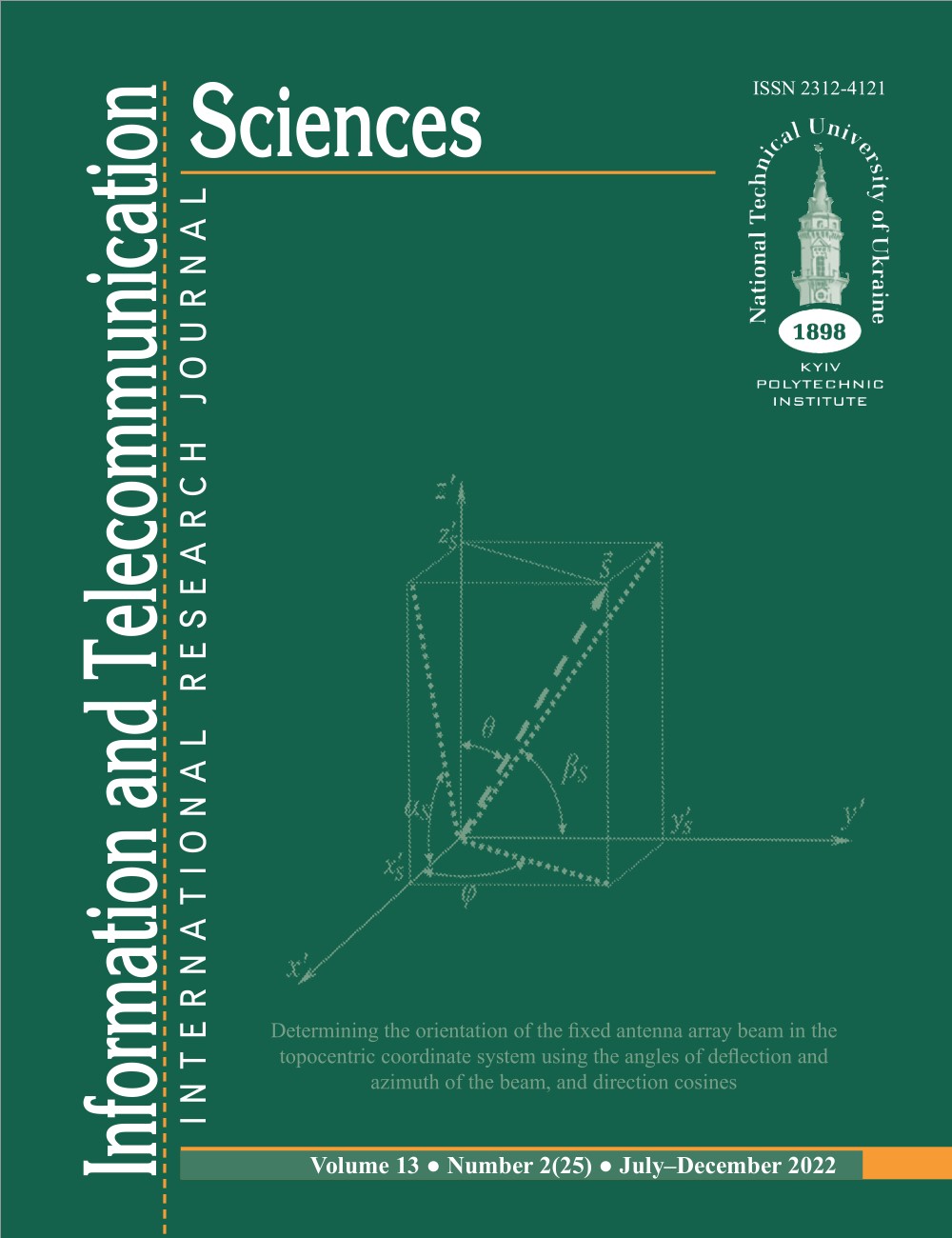STATIC AND DYNAMIC ASSESSMENTS OF INFORMATION SIGNS IN RECOGNITION OF SOURCES AND OBJECTS OF OBSERVATION IN THE PROCESS OF RADIO MONITORING
DOI:
https://doi.org/10.20535/2411-2976.22022.72-78Keywords:
radio monitoring, method, information feature, recognition, classification, evaluation, algorithm, similarity coefficientAbstract
Background. The current state and problems of the surveillance and radio monitoring systems of Ukraine require fundamentally new approaches to increasing their efficiency and the level of informatization. At the same time, the informatization of the radio monitoring system should be understood as the process of implementation and application in various areas of their activity of methods and means of collecting, transmitting, processing, saving and using information in order to increase the effectiveness of conducting radio monitoring and meet the needs of national security based on the formation and use of information resources.
Objective. The purpose of the paper is to increase the effectiveness of radio monitoring by using the calculation of estimates of dynamic and static informational features when recognizing sources and objects of radio radiation and determining their phase (operational) state and level of possible danger.
Methods. Recognition is based on the method of least squares by calculating the degree of "similarity" (similarity coefficient) of the recognized object with objects whose classes are known. Both the researched and reference objects are presented as a set of values of informational features of various nature, some of which are unchanged over the entire period of observation, that is, static, while others change dynamically.
Results. The structure of the automated system of classification and recognition of surveillance objects and the recognition algorithm based on the calculation of static and dynamic information features and the similarity coefficient are proposed.
Conclusions. A distinctive feature of deciding whether an object or a source of information belongs to one or another class feature is the calculation of the degree of "similarity" (similarity coefficient) of the recognized object to objects whose classes are known. To eliminate recognition errors associated with a violation of the synchronicity of measurements of the values of dynamic informational features of reference objects and objects to be recognized, a calculation is required taking into account possible time shifts.
References
Ilyashov O.A. Evaluation of the informativeness of monitoring features and signatures and the degree of their uncertainty when recognizing sources and monitoring objects in the information environment of telecommunication systems. - K.: Bulletin of NTUU "KPI". Radio engineering series, radio apparatus construction. 2016, No. 67. pp. 77 – 83.
Ilyashov O.A., Komarov V.S. Improvement of the signature-system method with the use of priority features in the composition of signatures of monitoring objects to ensure the maximum probability of correct recognition. - K.: Cybernetics and system analysis. - 2020, Vol. 56, No. 4. pp. 68-78.
Intellectualization of information message processing systems. Ed. Shlepakova L.N. – Kyiv: 1995. - 268 p.
Yu.Y. Zhuravlev, M.M. Kamikov, S.E. Tulyaganov. Algorithms for calculating estimates and their application. – Tashkent: 1974 .- 119 p.
Vasiliev V.I., Shevchenko A.I. Formation and recognition of images. - Donetsk: 2000. - 360 p.
Vasiliev V.I. Recognition systems. - Kyiv: Naukova Dumka, 1983. - 422 p.
Shlesinger M., Hlavach V.Ten lectures on statistical and structural recognition. -Kyiv: Nauk. dumka, 2004.-545 p.
Feinzilberg L.S. Mathematical methods of evaluating the usefulness of diagnostic signs. - Kyiv: Osvyta Ukrainy, 2010. - 152 p.
Downloads
Published
How to Cite
Issue
Section
License
Copyright (c) 2022 Аnatoliy Ilnytskyi, Oleg Tsukanov

This work is licensed under a Creative Commons Attribution 4.0 International License.
The ownership of copyright remains with the Authors.
Authors may use their own material in other publications provided that the Journal is acknowledged as the original place of publication and National Technical University of Ukraine “Igor Sikorsky Kyiv Polytechnic Institute” as the Publisher.
ITS articles are published under Creative Commons licence:
- Authors retain copyright and grant the journal right of first publication with the work simultaneously licensed under CC BY 4.0that allows others to share the work with an acknowledgement of the work's authorship and initial publication in this journal.
- Authors are able to enter into separate, additional contractual arrangements for the non-exclusive distribution of the journal's published version of the work (e.g., post it to an institutional repository or publish it in a book), with an acknowledgement of its initial publication in this journal.
- Authors are permitted and encouraged to post their work online (e.g., in institutional repositories or on their website) prior to and during the submission process, as it can lead to productive exchanges, as well as earlier and greater citation of published work.

